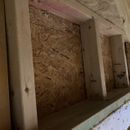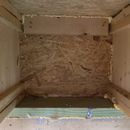Rim Joist Details with Open-Web Trusses
I live near Atlanta, GA, in climate zone 3. I am insulating my basement rim joist areas using 2″ XPS foam. I know there are reasons to prefer other foams to XPS, but this is left over supply from a family member’s project, so it already exists and is free to me.
I have open web trusses, and this has led me to a few questions because the detail differs a bit from any illustrations or explanations I have found. So, I have attached two photos of the details in question.
1. In the first picture, on the walls that run parallel to the truss joists, instead of a “real” rim joist I have what appears to be a short framed wall. My question is should I put a separate piece of 2″ XPS foam in each “stud cavity” directly against the OSB sheathing, or should I run a long piece over the vertical studs and horizontal top plate, leaving a 3.5″ deep air space between the XPS foam and the OSB sheathing?
2. In the second picture, on the walls that run perpendicular to the truss joists, there is no rim joist, and instead there is just OSB sheathing with a block of 2×4 at the top. Should I just fit a piece of 2″ XPS directly to the OSB (beneath the 2×4 block) and then when I spray Great Stuff to seal the corners, just liberally spray some of the Great Stuff over the 2×4 as well? Alternatively, other suggestions?
3. Since I am not finishing the ceiling below these rim joist areas, as I understand it, I need to put drywall over the XPS. I haven’t found any pictures of how this is typically done. Would I put the 2″ XPS and the drywall up loosely, and then spray the Great Stuff to seal it all in, or do I need to seal in the XPS before adding the drywall? Alternatively, does the drywall have to be directly in contact with the XPS, or could there be a few inches between their faces? I ask because it might be easier in my scenario to just run a piece of drywall from the rim sill plate up to the floor sheathing above, but this would leave approximately 3.5″ between the back of the drywall and the front of the XPS. If I did it this way, I think I would use Great Stuff on the XPS and then again on the drywall, making the space between them effectively sealed off from everything else.
4. Lastly, and I couldn’t get a good picture of this, I have one place where for some reason a 2x joist was installed (instead of an open web truss) directly next to an exterior wall, making it impossible to get to the rim joist area along that wall. Would it make sense to use XPS foam on and below that joist since I can not get to the rim joist area, or would that be either bad or pointless?
Thanks,
Steven
GBA Detail Library
A collection of one thousand construction details organized by climate and house part











Replies
Some locals will let you get by without the drywall thermal barrier, which is a fire code issue, but you’ll want to call your local building department to check first. If cutting and fastening all that drywall in place sounds like a big pain (and it is), you can also use mineral wool batts as fireproofing which are easier to fit into place. You can use the thinner “sound” type mineral wool batts for this purpose if you want.
You want to cut the foam to fit loosely, leaving maybe 1/2 to 1” gaps all the way around the piece. It helps to cut these edges with a bevel so that the expansion of the canned foam will help to push the XPS back against the rim joist and not out towards the open space. You want the XPS right against the rim joist.
Note that I like to use loctite tite foam here and not great stuff because tite foam is denser and more durable. While I haven’t done any formal testing, I’ve found the tite foam tends to hold up better over time so I like to use it in applications (like what you’re doing) where I can justify its higher cost over great stuff.
Bill
I'm going to stick with the Great Stuff because I already have about a dozen and a half cans for my foam gun.
Anyone have any advice on the specific questions I asked?
Thanks,
Steven
1- put a piece of XPS into each stud cavity. You don’t want an air space between the foam and the rim joist.
2- I would cut the XPS to fit directly against the OSB. I’ve had generally poor luck getting great stuff (or any canned foam) to make a good covering on anything flat. Canned foam likes to fill gaps, not cover surfaces, in my experience. This would be a great place to use one of the smaller 2 part foam kits, or you could cut a piece of XPS to cover the 2x4 and overlap the XPS on the OSB about the same amount as the thickness of the XPS that you’re using. Glue the piece in place with foam board adhesive to seal it to the lower XPS piece, then run great stuff around the perimeter in the usual way. Don’t try to glue the pieces together with great stuff, it will push things apart and make a mess. Been there, done that, won’t do it again :-)
3- either way works, but great stuff won’t hold drywall in place very well. I would cut the drywall to be a tight fit over the XPS, then use some foam board adhesive to glue it in place. You could run a larger sheet with an air space like you describe too. Mineral wool batts over the XPS will also work, and may be the easiest option for you to install (and gets you some extra R value too). This is a question you might want to run by your local building department since different localities sometimes want things done a particular way when it comes to fire blocks like this.
4- this one is a bit tricky. If the air space you can’t get to communicates with the outdoors, you’re probably ok using XPS over the joist you are able to reach. If that air space is sealed off by the exterior in such a way that it can’t ventilate, and thus can’t dry, then I’d be reluctant to use XPS here since thicker XPS like you’re using is a vapor barrier.
I actually have that same situation in my own home, with a joist that blocks access to the actual rim joist. Since I have foil faced polyiso on the exterior, I didn’t expect a lot of drying ability for that cavity. My solution was to install 2” EPS — which is slightly vapor open — on the inside to allow for a small amount of drying ability. I just glued the EPS in place on the accessible joist.
Bill
Thanks Bill, I appreciate the advice.
Steven
Hey everyone!
I've been reading through Steven's post about his basement rim joist insulation project with open-web trusses, and I must say, it's quite an interesting situation. It's great that Steven has access to free 2" XPS foam, even though there may be other foam options preferred by some. Now, onto the questions he has.
1. Regarding the first picture, where there's a short framed wall instead of a "real" rim joist, I think it would be best to run a long piece of 2" XPS foam over the vertical studs and horizontal top plate. This way, a 3.5" deep air space can be created between the XPS foam and the OSB sheathing, allowing for better insulation and moisture control.
2. In the second picture, where there's just OSB sheathing and a 2x4 block, I would suggest fitting a piece of 2" XPS foam directly to the OSB beneath the 2x4 block. When applying Great Stuff to seal the corners, spraying some over the 2x4 as well would be a good idea to ensure a tight seal.
3. As for finishing the ceiling below the rim joist areas, it's important to put drywall over the XPS. While I haven't seen specific pictures of this, I believe it would be best to seal the XPS with Great Stuff before adding the drywall. The drywall should ideally be in direct contact with the XPS, but if there's a few inches between their faces, using Great Stuff on both the XPS and the drywall can effectively seal the space.
4. Regarding the area where a 2x joist was installed instead of an open web truss, making access to the rim joist area impossible, I think using XPS foam on and below that joist would be a reasonable solution to ensure insulation continuity.
These are just my thoughts and suggestions, so feel free to share your opinions and insights on the matter. Good luck with your project, Steven!
Hey everyone!
I've been reading through Steven's post about his basement rim joist insulation project with open-web trusses, and I must say, it's quite an interesting situation. It's great that Steven has access to free 2" XPS foam, even though there may be other foam options preferred by some. Now, onto the questions he has.
1. Regarding the first picture, where there's a short framed wall instead of a "real" rim joist, I think it would be best to run a long piece of 2" XPS foam over the vertical studs and horizontal top plate. This way, a 3.5" deep air space can be created between the XPS foam and the OSB sheathing, allowing for better insulation and moisture control.
2. In the second picture, where there's just OSB sheathing and a 2x4 block, I would suggest fitting a piece of 2" XPS foam directly to the OSB beneath the 2x4 block. When applying Great Stuff to seal the corners, spraying some over the 2x4 as well would be a good idea to ensure a tight seal.
3. As for finishing the ceiling below the rim joist areas, it's important to put drywall over the XPS. While I haven't seen specific pictures of this, I believe it would be best to seal the XPS with Great Stuff before adding the drywall. The drywall should ideally be in direct contact with the XPS, but if there's a few inches between their faces, using Great Stuff on both the XPS and the drywall can effectively seal the space.
4. Regarding the area where a 2x joist was installed instead of an open web truss, making access to the rim joist area impossible, I think using XPS foam on and below that joist would be a reasonable solution to ensure insulation continuity.
These are just my thoughts and suggestions, so feel free to share your opinions and insights on the matter. Good luck with your project, Steven!